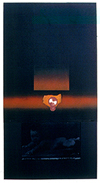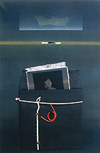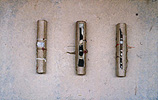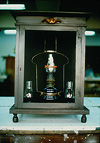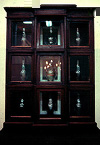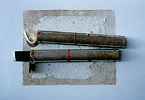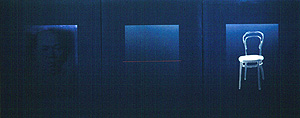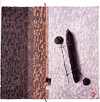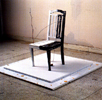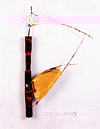 |
 |
 |
|||||||||||
 |
 |
 |
 |
 |
|||||||||
 |
|||||||||||||
CREATIVE IDEA OF HIS WORK
Pisnu Suphanimit, an ex-Dean, Faculty of Painting Sculpture and Graphic Arts, Silpakorn University,
once wrote about Thavorn and his work : “Coming so far on the path of art, Thavorn experienced
many tesimonials. The crucial point is that he has never ceased striving with his intellects. Thus, his
inner self is revealed in his work. He finds meaning in muteness, working from the simplicity of nature
and leading to the realm of faith and soul. Thavorn finds great values of the universe from materials.
” The starting point of Thavorn’s work was his love and fascination on techniques and processes of
graphic arts. Each time he touched a working block, he felt enthusiastic to find what image he would
create. He worked in his own way, which is different from conventional approaches. For example,
instead of using the right - front of printing block, he used the opposite side. Sometimes he picked up
some materials from the street to be an element for his prints in his own style. His creative thinking
reflected in all of his works. Thavorn always worked in series, which lasted from 3 - 5 years.
When he finished one work, he would begin to think about a new undertaking, another track. More than
3 decades, Thavorn revolved around a single idea, with various techniques and dimensions to express
a particular vision. Thavorn began with fine prints, then refined and reflected memories of his own childhood.
Lately, Thavorn experimented making prints together with other kinds of materials, entering new dimension
with the use of mixed media. He bringing from, depth and space together into a unity. In later years, he used
fewer printing techniques. There are so many printing processes and Thavorn was tired of the complications .
When he was bored, he stopped for an entire year without making prints. When he feel better, he began to
work again. Thavorn felt that printmaking was useful for him because he always used some blocks over and
over again, making new and various images in a number of editions. This made him be able to send his work to
exhibitions all over the world.Thavorn’s creative series can be divided in five periods with varying ideas.
The First Period
The content of the prints in this series suggested his impressions on the significance of the past: situations,
objects, and the family relationships, which are part of life of Chinese-Thai lives. Thavorn used his own family
photographs as symbols reflecting the situation of Chinese ancestor in Chinese-Thai families.
The Second Period
Thavorn’s past impressions still continued in this period. He also believed that personal belongings used for
a long time would eventually become a reflection of the owner’s personality. Objects symbolized people and
generated an image of the past family relationships. In this series, objects used to convey meanings were
tables, chairs, lamps, ornaments, etc. These things represented in relief etchings, photos, silk-screens,
and collages.
The second Period
This is the period of symbols in rituals. Thavorn was interested in many Chinese rituals. When he was young ,
he enjoyed meeting cousins and travelling up country. He was a considerate one when he grew up. When
studying arts, he thought in retrospect into rituals, which reflected the way of thinking. Materials: stones and
bamboo reflected philosophy and beliefs. Moreover, Thavorn got some inspiration from joining rituals himself.
Therefore, He developthis way of using materials to present hidden ideas, beliefs, faiths, power, and imagination
from personal rituals. These materials appeared in this series that carried on for a long time, until he was
successful locally and worldwide for the idea he developed.
The fourth Period
While sitting by his father’s bed in the hospital, Thavorn studied the Lord Buddha’s preaching from religious
books and sermons of the Reverend Cha and Reverend Buddhatas. He perceived an idea, “Things change
according to its own nature or law, be soft and strong like water adjust directions to the container”.
The profound teachings inspired him to chose many kinds of media for new series of collages, for example,
using rocks and gold color.
The fifth Period
This period was called “ Belief without Reason”. Despite the development of education, science and technology,
beliefs in superstitions or sacred objects still had power on Thai society. The artist observed superstitious belief
in amulets among Buddhist laity. He used a variety of symbols to treat this concept, using forms of different
objects to suggest different meanings. In this series, Thavorn compared objects in nature such as rocks and
dry wood. He concluded that amulets for good life actually reflected hidden fears. In the contrary, the objects
born out of natural processes reveal Dharma, the essential path to inner peace.
